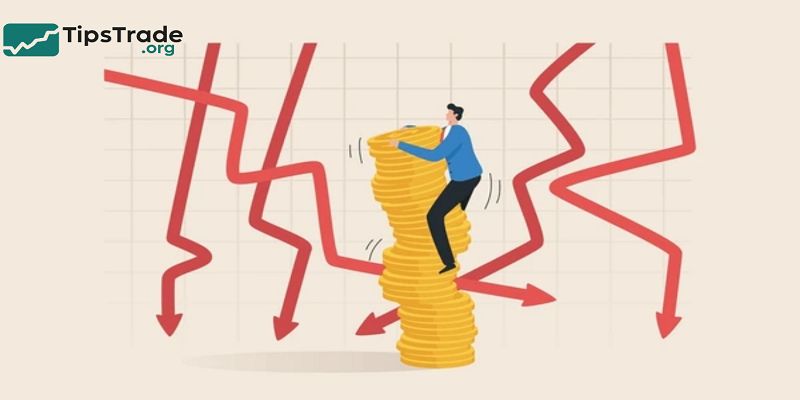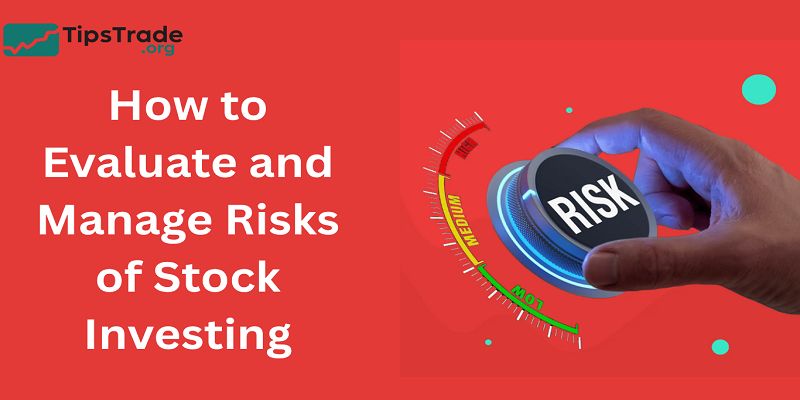Risks of stock investing are inherent and can significantly impact an investor’s returns. These risks include market volatility, economic downturns, company-specific issues, and geopolitical events that can cause stock prices to fluctuate unpredictably. Understanding these risks is essential for making informed investment decisions and managing a balanced portfolio effectively. Visit tipstrade.org and check out the article below for further information.
Why Risks of Stock Investing
- The stock market operates on uncertainty. Every share represents partial ownership of a company, and a company’s value changes as business conditions evolve.
- External forces like economic cycles, inflation, interest rate shifts, and geopolitical events can cause stock prices to rise or fall sharply.
- Unlike savings accounts or government bonds that offer guaranteed returns, stocks carry market risk — the possibility that prices will move against you.
- This volatility can be unsettling, especially for beginners.
- For instance, the S&P 500 lost more than 50% of its value during the 2008 global financial crisis but rebounded in the years that followed. Investors who sold during the panic locked in losses; those who stayed invested recovered and profited.
In essence, risk and return are inseparable. The potential for higher returns comes only by accepting higher uncertainty. Smart investors don’t fear risk — they prepare for it.
Major Types The Risks Of Stock Investing

Market Risk (Systematic Risk)
- Market risk — also called systematic risk — is the possibility that the overall stock market declines, dragging down nearly all individual stocks regardless of their fundamentals.
- Factors that contribute to market risk include recessions, wars, interest rate hikes, or global crises. For example:
- In March 2020, at the onset of the COVID-19 pandemic, the S&P 500 fell over 30% in a single month.
- In 2008, the financial crisis wiped out $8 trillion in U.S. household wealth.
You can’t eliminate market risk entirely, but you can mitigate it by maintaining a long-term horizon, diversifying across asset classes, and avoiding emotional trading during volatility.
Company-Specific Risk (Unsystematic Risk)
While market risk affects all companies, unsystematic risk is unique to an individual company or industry.
This may stem from:
- Poor management decisions
- Product recalls or lawsuits
- Supply chain disruptions
- Accounting scandals
A classic example is Enron (2001) — once a Wall Street darling, the company collapsed due to fraudulent accounting, costing investors billions.
Similarly, Lehman Brothers (2008) demonstrated how corporate mismanagement can destroy shareholder value overnight.
The best defense is diversification. By owning stocks in multiple sectors and industries, losses in one company are offset by gains elsewhere.
Liquidity Risk
Liquidity risk occurs when investors cannot quickly sell their shares without affecting the stock price. This is more common with small-cap stocks or companies listed on smaller exchanges.
Imagine you own shares in a small technology firm that trades only a few thousand shares per day. If you suddenly need to sell, you may have to accept a steep discount — or wait days for buyers to appear.
To manage liquidity risk:
- Focus on companies with strong trading volume
- Avoid overconcentration in micro-cap or penny stocks.
- Maintain a portion of your portfolio in highly liquid assets like ETFs or blue-chip stocks.
Interest Rate and Inflation Risk
Interest rates and inflation are two macroeconomic factors that heavily influence the stock market.
When interest rates rise, borrowing costs increase for businesses, potentially reducing earnings. High interest rates also make bonds more attractive, prompting investors to shift money away from stocks.
Inflation, on the other hand, erodes purchasing power. It can hurt consumer spending and corporate profits. For instance, during 2022, when global inflation surged above 8%, stock markets worldwide posted negative returns as investors feared central bank tightening.
However, not all stocks respond the same way:
- Banks and financials may benefit from higher interest rates.
- Energy and commodities often outperform during inflationary periods.
- Tech and growth stocks tend to suffer when borrowing costs rise.
Balancing your portfolio across different sectors can cushion these macroeconomic shocks.
Regulatory and Political Risk
Political and regulatory decisions can reshape industries overnight. New tax policies, trade tariffs, or environmental regulations can increase business costs or restrict operations.
Examples:
- In 2018, U.S.-China trade tensions led to volatile swings in technology and manufacturing stocks.
- In 2021, China’s crackdown on tech companies wiped out over $1 trillion in market capitalization.
Investors should stay informed about political developments and avoid overexposure to heavily regulated industries. Geographic diversification — owning international stocks — can also reduce exposure to one country’s political climate.
Behavioral and Emotional Risk
Behavioral finance research by Daniel Kahneman and Amos Tversky (1979) shows that investors are often irrational. They overreact to short-term news, chase trends, and let emotions drive decisions.
Common behavioral biases include:
- Loss aversion: fear of losses causes premature selling.
- Herd mentality: following others without independent analysis.
- Overconfidence: assuming one can time the market.
For instance, during the meme-stock frenzy of 2021, many retail investors bought heavily into GameStop and AMC at inflated prices, only to lose large sums later.
Concentration Risk
- Concentration risk arises when too much of your portfolio is invested in a single stock or sector.
- If that company fails or the industry suffers, your portfolio can take a severe hit.
- For example, employees who invested most of their 401(k)s in Enron stock lost both their jobs and retirement savings when the company collapsed.
- Financial planners recommend limiting any single stock to no more than 5–10% of your portfolio.
- ETFs or index funds can help maintain diversification without constant management.
How to Evaluate and Manage Risks of Stock Investing

The Core of Risk Management
Diversification means spreading investments across different asset classes (stocks, bonds, real estate, commodities) and sectors (technology, healthcare, finance).
According to Morningstar research (2023), a well-diversified portfolio of 25–30 stocks can reduce unsystematic risk by over 90%.
Methods include:
- Index funds or ETFs such as S&P 500 or MSCI World.
- Sectoral balance — don’t over-weight any one industry.
- Geographic diversification — mix domestic and international stocks.
Diversification doesn’t eliminate losses, but it makes portfolios more resilient.
Assessing Risk Tolerance and Time Horizon
Your ability and willingness to handle losses define your risk tolerance. A young professional saving for retirement in 30 years can handle more volatility than a retiree depending on investments for income.
Questions to assess risk tolerance:
- How would you feel if your portfolio dropped 20%?
- What’s your investment timeframe — 1, 5, or 20 years?
- Are you investing for growth or income?
Financial advisors use risk-profiling tools to match clients with appropriate portfolios — conservative, balanced, or aggressive.
Research and Fundamental Analysis
Before buying any stock, investors should analyze the company’s fundamentals:
- Revenue growth and profit margin
- Debt-to-equity ratio
- Cash flow stability
- Competitive advantages (moat)
Websites like Morningstar, Yahoo Finance, and Seeking Alpha offer free data for evaluation.
Warren Buffett famously said: “Risk comes from not knowing what you’re doing.”
Doing the homework drastically reduces uncertainty.
Entry and Exit Strategies
Timing the market perfectly is impossible, but disciplined strategies help manage downside risk.
Common methods:
- Dollar-Cost Averaging (DCA): invest a fixed amount regularly regardless of price — reduces emotional timing.
- Stop-Loss Orders: automatically sell a stock if it drops below a preset price, preventing large losses.
- Target Pricing: predetermine when to take profits or cut losses.
For example, an investor might buy $1,000 of an ETF monthly (DCA) and set a 10% stop-loss on volatile holdings. This builds discipline and removes emotional bias.
Regular Portfolio Monitoring and Rebalancing
- Over time, some stocks outperform, others lag — changing your portfolio’s risk profile.
- Rebalancing restores it to your target allocation.
Example:
If tech stocks rise sharply and now make up 60% of your portfolio (vs. 30% initially), selling part of them and reallocating to bonds or underweighted sectors brings balance.
Vanguard’s studies show that annual or semi-annual rebalancing improves long-term returns and lowers volatility.
Real-World Case Studies and Lessons Learned

The Dot-Com Bubble (2000–2002)
- In the late 1990s, investors poured billions into internet startups with no profits.
- By 2000, valuations became absurd — companies with no revenue traded at billions.
- When the bubble burst, the Nasdaq Composite fell 78%, erasing $5 trillion in value.
- Lesson: speculative hype and herd behavior amplify risk. Solid fundamentals matter more than popularity.
The Global Financial Crisis (2008–2009)
- Banks engaged in risky lending and excessive leverage, creating a housing bubble that collapsed in 2008.
- The S&P 500 lost over 50%. Yet, long-term investors who stayed the course saw the market recover and reach record highs by 2013.
Lesson: diversification and emotional control help survive extreme downturns.
COVID-19 Crash and Recovery (2020)
- When COVID-19 spread globally, markets fell at record speed. Within weeks, trillions vanished.
- But massive stimulus and digital adaptation led to a historic rebound.
- Investors who sold out missed one of the strongest rallies in modern history.
Lesson: market timing is futile; long-term conviction pays off.
Avoiding Common Mistakes
| Common Mistake | Consequence | Better Practice |
| Investing without research | Buying weak companies | Study fundamentals and financial reports |
| Chasing hot stocks | Buy high, sell low | Focus on intrinsic value |
| Ignoring diversification | Higher volatility | Spread across sectors |
| Letting emotions drive trades | Panic selling | Stick to a written plan |
| Overlooking fees and taxes | Lower net returns | Use tax-efficient accounts |
| Trading too often | Higher costs | Invest, don’t speculate |
Practical Tips:
- Maintain an emergency fund separate from investments.
- Start small; scale as confidence grows.
- Keep a long term perspective — years, not weeks.
- Read reliable sources: The Intelligent Investor, A Random Walk Down Wall Street, Morningstar Guides.
Conclusion
Risks of Stock Investing is not gambling — it’s calculated risk-taking. Every share you buy carries uncertainty, but also the potential for reward. By understanding market, company, and emotional risks, you turn volatility from an enemy into an ally. Successful investors — from Warren Buffett to everyday savers — share one principle: manage risk, don’t fear it. Through diversification, research, and discipline, you can navigate market turbulence and steadily grow wealth over time

